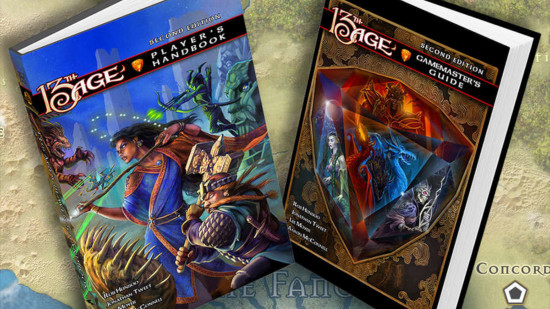DnD 5e may be the most popular fantasy RPG, but for former lead DnD designers Rob Heinsoo and Jonathan Tweet, it’s got nothing on 13th Age. We spoke to Heinsoo about how he and his partner in design made their definitive D20 RPG, and what’s changing for the game’s upcoming second edition.
As a brief backstory to the pair, Heinsoo was part of the lead design team that wrote DnD fourth edition, while Tweet was the lead author for the third edition core rulebooks. They’re true tabletop RPG fanatics, playing together in the same Wednesday night gaming group since 1998. Naturally, DnD was an extremely popular game at their table – until they started work on 13th Age…
“What we were trying to do was to design the version of the DnD style game that we wanted to play together on Wednesday night”, Heinsoo recalls. It’s very much designed around his and Tweet’s predilections and preferences.
He contrasts it with the crowdsourced design for DnD 5e, which went through an expansive playtesting process “finding out how many people liked this version and how many people like that version”, before settling on something with more in common with DnD second edition than either third or fourth edition.
13th Age was first published in 2013. Heinsoo says it was never intended to become a full game line: “we thought we were just doing one book!” Publisher Pelgrane Press has expanded the game mightily with supplements since then. A Kickstarter campaign to fund 13th Age second edition is running until 11am PT / 2pm EST / 7pm BST on June 6, but Heinsoo says that a second edition was never part of the plan, either.
Heinsoo explains that he really dislikes “the whole Warhammer thing” where edition changes mean players need to repurchase core rules and their army’s Warhammer 40k Codex every three years. He didn’t want to inflict that on 13th Age fans.
But he was inspired by the work Joseph McCullough did making a revised second edition of his indie wargame Frostgrave: “He was updating all the powers and spells that people weren’t choosing so often because they weren’t measuring up”, Heinsoo explains, while keeping the rules backwards compatible with supplements. “That’s what 13th age has been missing”.
That’s good news for existing players with a large library of sourcebooks, as those will be broadly compatible. For newcomers, Heinsoo is hopeful that the new edition has made flagship features of the game that distinguish it from DnD 5e easier for them to get into.
The Icon Connection system is one of them. The setting for 13th Age is intentionally open-ended, but thirteen powerful NPCs called Icons cast long shadows over the world. These are archetypical fantasy characters like the Emperor, the Liche King, and the High Druid, with agents and schemes active across the world. Each player character has Connections with the Icons and their organisations, which can introduce unexpected wrinkles into the narrative, both help and hindrance.
But according to Heinsoo, “Jonathan and I had been sort of vague” in the rules for that system in first edition, with important rules buried in out of the way paragraphs. When talking to players who love the game, he found that “no two really good experienced Game Masters were using the Icon Connection system the same way”. That shouldn’t be an issue in the second edition: “the book went from maybe three pages of vague information about it to around 60 pages of examples”.
That might sound like a lot of examples, but the 13th Age rules have always used extensive examples and commentary to emphasise the freedom that GMs and players have in interpreting the game. Some of this takes the form of back-and-forth conversations between Heinsoo and Tweet – which reflects the way the two of them operate as designers. Either of them might draft a new set of spells, powers, or class for the game, before the Wednesday gaming group play with it and the other scrutinizes it.
To hear Heinsoo describe their group’s playtesting process, he’s the one most likely to give players powerful new abilities in the name of fun, and Heinsoo is the one who chops out everything that’s overpowered. “Jonathan’s really quite excellent at figuring out how things balance”, Heinsoo says, but this has earned him the nickname “the enemy of fun”. As for their disagreements, “we each win about 50% of the time because we’re each right about 50% of the time”.
Sometimes, the two of them will realise something needs changing for totally different reasons. As an example, Heinsoo describes noticing the Wednesday group’s Ranger player getting bummed out by how much cooler and flashier the redesigned Wizard was than their character. Tweet diagnosed that the first edition ranger “had some abilities that were always available”, which meant they “had to be terrible” for balance purposes. Obviously that needed fixing.
Heinsoo is working on the second edition Ranger right now, which aims to make everything feel better. He gives the example of the animal companion, which in first edition worked a lot like it does for the Ranger 5e DnD class, “like an extra character, just not as interesting” to preserve game balance.
That’s been restructured – while the Ranger’s puma, wolf, or eagle might always be at their side, mechanically it’s “something that the player can use a certain number of times in an arc”, with “really interesting abilities that do a lot more damage”.

If DnD 5e isn’t scratching the itch for you any more and you don’t fancy ramping up into the much more complex world of Pathfinder, we heartily recommend you try out 13th Age – the video above by YouTuber Polyhedron gives a good quick overview of what makes it unique. And if you want to know more about Tweet and Heinsoo’s design credentials, check out our guide to previous DnD editions to learn more about third and fourth edition.
Source: Wargamer




